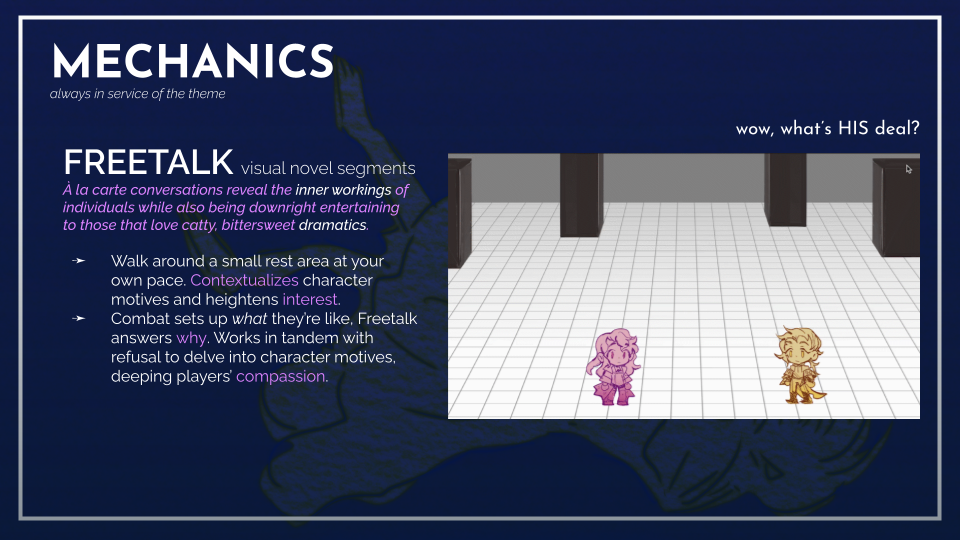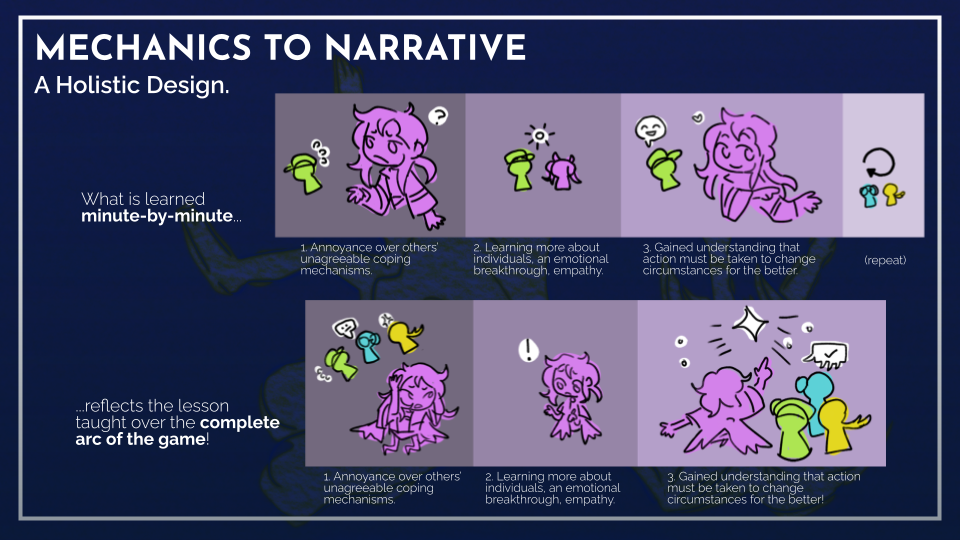STARWEAVE
Who the stars dictate we’ll be.
STARWEAVE is a squad rpg that utilizes tactical gameplay and allegorical narrative design to the end of encouraging players to exercise compassion when a cast of hurting teens lash out and even revolt against the player’s very tactical commands in a dire and oppressive situation. Why must we follow our destiny? Why must we play the roles lain out before us?
Genre: Tactics, RPG, Narrative
Platform: PC & Mac, single-player
Engine: Unity
Team: 60+ members; 10 teams.
Duration: March 2022 - Present
Roles & Contributions
Creative Director: leading 60+ developers across 10 teams, conducting meetings, people management, cross-functional communication, visual direction, audio direction, world bible.
Game Designer: tactical gameplay, narrative design, ludonarrative, emotional game loop, technical document writing, prototyping, scripting.
Game Artist, UI/UX: character designs, UI wireframes





My Design process — A Holistic Experience about Empathy.
Design Goal: mentalization. understanding that other characters have their own motivations, personalities, and beliefs—and working with them.
Core Loop: engage in tactical rpg combat, encounter teammates refusing commands, investigate motives, accommodate teammates in combat.
Characters: explicit dialogue and subtle behaviors work in tandem, their struggles are revealed through gameplay, then corroborated textually.
Narrative Design: mirrors the core loop as an arc. builds up the player’s relationship with compassion on a micro and then a macro scale.
STARWEAVE is a game about understanding the intricacies and nuances of disparate pained individuals, so it was my guiding intention to center everything around its characters. The pain presented is rooted in real world struggles: gender roles, racial stereotypes, discrimination, but the game discusses this matter and pushes its intent that ‘compassion is good’ through the approachability of fiction: understanding that centering a player’s emotional experience and intellectual agency is more effective than a preaching stance.
So the theming is done through layered metaphor. The characters: Dreamer, Troubadour, Blackguard, Lighthouse, and non-player Bird, each emblematize a different flawed coping mechanism when forced into a role. On top of being given stringent titles, the teens are thrust into a cyclical quest, one where they must box themselves into their set purposes to succeed and uphold the world as they know it. Thus, the youth must maintain the status quo.
Dreamer, the player, is designated party leader. The player—who we know arrives to the game an ignorant party—commands the others in Combat according to their corresponding healer, rogue, and supporter designations: naturally forcing them into their roles. To incite challenge to this is the crux of the game: the refusal mechanic. The other characters can elect to not follow their commands. For example, Troubadour is a healer who does not feel confident in his role, but believing he can fake it ‘til he makes it, will force himself to keep going; if an ally has even the smallest paper cut, he will ignore you to go heal them. This expression of individualism sets up a mystery for the player: that’s not proper, why in the world are their teammates doing that?
This dovetails into the Freetalk system, wherein the player chooses to spend a limited amount of time better connecting with a teammate. They reveal their personal beliefs and internal struggles, providing context to their reactive behavior during Combat. The mystery gains answers. Troubadour professes that he doesn’t want to let the others down, and the player can now understand how to accommodate this the next round of Combat.
The player now brings allies to Troubadour and allows him to heal from a safer spot without the pressure to push into danger. Accommodated for, Troubadour reciprocates the player’s compassion by meeting them in the middle: loosening up on his reactive behavior now that they’ve shown compassion. This feedback loop repeats as players also contest with the rest of their teammates, achieving the experience goal over and over again.
Prototyping: Mechanical Tools for a ludonarrative.
This game, being narratively driven, started with its themes and story beats. Mechanics and systems had to wholeheartedly support a ludonarrative. I made several paper and digital prototypes to test out how to best convey the game’s core conceit of characters and their pained perspectives, as well as how to carry along the emotional progression of: conflict → investigation → understanding → compassion → action.
These prototypes investigated whether:
ambiguating the ‘rules’ behind a character not wanting to reach a goalpost would be treated like a puzzle to solve.
The arc is a long one, so each prototype breaks down and tries to address just a few parts of it—if I had the time, it would have been nice to try and string multiple together. Playtesting and design investigations were synthesized into the refusal-behavior mechanic, intended player journey, and reciprocal feedback loop detailed in the previous section.
Design Considerations for a Development Team.
STARWEAVE is a project with a team of over 60 volunteers. That’s an astronomical quantity of people to guide, unite, and manage. While I have been a Lead or Manager on projects before, this was certainly a much grander scale. I successfully led the team through a combination of means.
Clarity of direction was provided by preparing technical documents such as a comprehensive game macro, milestone roadmap, high-level GDD, color script, art direction deck, audio deck, and world bible—and deepening my own knowledge of crafts such as 3D and V/O when they were lacking prior to the project. A culture of communication and team rapport was established early, both through structuring departmental channels with open door policies and bonding activities. And lastly, embodying the spirit of the game, I made immense efforts to understand where each team member was coming from: their personalities, how they best communicated, their personal goals, and how to provide tools and learning opportunities to make the project a rewarding pursuit for everyone.
Examples of the subsequent Level Specs, Paper Prototypes, and In-Unity Levels the Design team have worked on together.
Deep dive: User interface efficacy.
In addition to mechanical game design and overall direction, I also devised the UI systems for the game. Conducting research under the guidance of Game Designer Richard Lemarchand, I audited 30 years of digital narrative games, analyzing why and how they visually represented dialogue.
This information was used to design the Combat and Freetalk screens in STARWEAVE. Combat features a small, impersonal textbox that treats the person talking as a faraway pawn upon a tactical board. By deliberate contrast, Freetalk, a social segment, uses larger speech bubbles with personal information and facial expressions, and thereby players closer relate to the characters.
I was invited to present my findings and applications at USC’s Annenberg Creative Research Symposium.
Lessons Learned.
What went well.
A clear vision, a solid development action plan, and a powerful message are what drew in such a large group of developers to this production. It’s not lost on me that the scale at which we’re able to produce this game came from a clear, confident direction, institutional knowledge built up from my prior productions, and a little bit of heart.
On top of robust roadmaps, burndowns, and pipelines, a team of 60+ requires clear communication and conscientious attention towards the needs, temperaments, and personal goals of each member on the team. Building rapport with the team, coaching leads as needed, and incorporating team retrospectives has ensured that our team continues to stay healthy and improve our processes as we continue.
Areas of improvement.
The games I create follow a values-driven approach. This means the emotional goals of the narrative serve as a ‘north star’, this guides the process of prototyping mechanical affordances that strongly express this experiential goal, all decisions are made based on how they boost what have been identified as the ‘win-condition’ values. This is a design practice of mine that works very well for lightweight games, but can be difficult to scale up when a system gains complexity: the raw mechanical consideration behind character stat spreads skills, the information design behind grid movement, the ‘fun’ factor of tactics, run the risk of muddying up the clarity of this direction, and so a balance needs to be struck.
The process of effectively using QA will ensure that the game is conferring enjoyment without taking the edge off the experience, it seems that QA is always factored into the process of game development too ‘late’ but nonetheless I have learned the merit of considering the involvement of QA from the moment the initial high-level GDD is conceived as preproduction.
Closing thoughts.
This only reflects my thought as of the midway point of production. I have never made something at this scale and am excited to celebrate our successes, but most importantly learn from our failures and shortcomings to improve both myself and my design process for what next big thing comes down the line on my creative journey!





























